By Rana Aylo
•
January 21, 2025
Back pain is a common issue that affects many people, often impacting their quality of life. One effective way to alleviate or prevent back pain is by strengthening your core muscles. But what exactly are core muscles, and how do they help with back pain? What Are Core Muscles? Core muscles refer to a group of muscles in the central part of your body that are responsible for stabilizing your spine, pelvis, and trunk. These muscles play a critical role in supporting your daily movements, maintaining proper posture, and ensuring balance. Core muscles include: Abdominals: Rectus abdominis: The "six-pack" muscle that helps with trunk flexion. Transverse abdominis: The deepest abdominal muscle, vital for core stability. Obliques: The muscles on the sides of your torso, crucial for rotation and lateral movements. Glutes: The glutes (gluteus maximus, medius, and minimus) are responsible for hip extension, stabilization, and supporting the pelvis. Back muscles: Erector spinae: A group of muscles that run along the spine, helping to extend and stabilize the back. Pelvic floor muscles: These muscles help control bladder function and support the organs in the pelvis. How Strong Core Muscles Help Reduce Back Pain A weak core is one of the primary contributors to lower back pain. Without a strong foundation, your spine and pelvis are more vulnerable to strain and misalignment. Weak core muscles can lead to poor posture, excessive pressure on the lower back, and an increased risk of injury. Here’s how a strong core can help: 1. Spinal Stability: A strong core acts like a brace for your spine, preventing unnecessary movements and ensuring that your back stays aligned. This is crucial for reducing the risk of strain and discomfort in the lower back. 2. Improved Posture: Strengthening your core muscles encourages good posture, reducing the chances of slumping or rounding your back. Proper posture minimizes stress on the spine and lower back. 3. Pelvic Support: The glutes and pelvic floor muscles provide support to the pelvis. Weak glutes can lead to pelvic instability, which can contribute to lower back pain. 4. Balanced Movement: Core muscles are involved in almost every movement. By strengthening them, you improve your overall balance and coordination, reducing the risk of awkward movements that could strain your back. Effective Core Exercises to Reduce Back Pain Incorporating core exercises into your fitness routine is essential for preventing and alleviating back pain. Here are some effective exercises that target the core muscles: 1. Planks: Planks are an excellent exercise for strengthening the entire core. Start by holding a push-up position with your arms straight, keeping your body in a straight line from head to heels. Engage your core muscles and hold for as long as possible, aiming to increase your duration over time. 2. Bridges: Bridges are great for targeting the glutes, lower back, and hamstrings. To perform a bridge, lie on your back with your knees bent and feet flat on the ground. Lift your hips toward the ceiling while keeping your shoulders and feet on the floor. Squeeze your glutes at the top and hold for a few seconds before lowering your hips back down. 3. Dead Bugs: This exercise engages the entire core, particularly the transverse abdominis. Lie on your back with your arms extended towards the ceiling and your knees bent at 90 degrees. Slowly lower your right arm and left leg toward the floor while keeping your lower back pressed into the ground. Return to the starting position and repeat on the opposite side. 4. Bird-Dogs: Bird-dogs are a great way to improve balance and strengthen the lower back and core. Start on your hands and knees, with your back flat and your core engaged. Extend your right arm forward and left leg backward simultaneously, keeping your hips and shoulders square. Hold for a few seconds, return to the starting position, and repeat on the opposite side. Tips for Building Core Strength 1. Consistency: Like any muscle group, your core needs regular training to grow stronger. Aim to include core exercises in your routine 2–3 times per week for optimal results. 2. Engage Your Core During Daily Activities: You don’t need to be working out to strengthen your core. Engage your core while sitting, standing, or walking to build muscle strength throughout the day. 3. Focus on Proper Form: It’s important to focus on proper technique during core exercises. Performing exercises with correct form will maximize their effectiveness and reduce the risk of injury. 4. Gradually Increase Intensity: Start with basic exercises and gradually increase the difficulty level. As your core becomes stronger, you can challenge yourself with advanced variations or add resistance for more intensity. A Note on Health and Medical Advice While strengthening your core can play a significant role in alleviating and preventing back pain, it is important to note that this information is for general fitness purposes and should not be considered a substitute for medical advice. If you have a pre-existing condition or chronic back pain, it’s always best to consult with a healthcare professional or physical therapist to determine the appropriate treatment and exercise plan for your specific situation. Conclusion A strong core is essential for maintaining a healthy, pain-free back. By strengthening your abdominals, glutes, back muscles, and pelvic floor, you can stabilize your spine, improve your posture, and reduce the risk of back pain. Incorporating exercises like planks, bridges, dead bugs, and bird-dogs into your fitness routine will help you achieve a stronger, more supportive core, ultimately leading to better overall health and reduced back pain.












